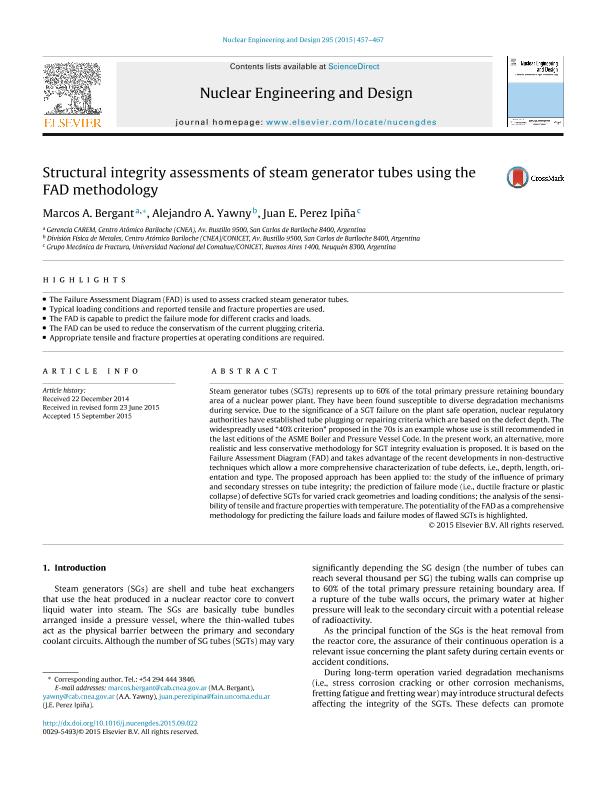Mostrar el registro sencillo del ítem
dc.contributor.author
Bergant, Marcos Antonio

dc.contributor.author
Yawny, Alejandro Andres

dc.contributor.author
Perez Ipiña, Juan Elias

dc.date.available
2018-06-27T01:04:17Z
dc.date.issued
2015-12
dc.identifier.citation
Bergant, Marcos Antonio; Yawny, Alejandro Andres; Perez Ipiña, Juan Elias; Structural integrity assessments of steam generator tubes using the FAD methodology; Elsevier Science Sa; Nuclear Engineering and Design; 295; 12-2015; 457-467
dc.identifier.issn
0029-5493
dc.identifier.uri
http://hdl.handle.net/11336/50246
dc.description.abstract
Steam generator tubes (SGTs) represents up to 60% of the total primary pressure retaining boundary area of a nuclear power plant. They have been found susceptible to diverse degradation mechanisms during service. Due to the significance of a SGT failure on the plant safe operation, nuclear regulatory authorities have established tube plugging or repairing criteria which are based on the defect depth. The widespreadly used "40% criterion" proposed in the 70s is an example whose use is still recommended in the last editions of the ASME Boiler and Pressure Vessel Code. In the present work, an alternative, more realistic and less conservative methodology for SGT integrity evaluation is proposed. It is based on the Failure Assessment Diagram (FAD) and takes advantage of the recent developments in non-destructive techniques which allow a more comprehensive characterization of tube defects, i.e., depth, length, orientation and type. The proposed approach has been applied to: the study of the influence of primary and secondary stresses on tube integrity; the prediction of failure mode (i.e., ductile fracture or plastic collapse) of defective SGTs for varied crack geometries and loading conditions; the analysis of the sensibility of tensile and fracture properties with temperature. The potentiality of the FAD as a comprehensive methodology for predicting the failure loads and failure modes of flawed SGTs is highlighted.
dc.format
application/pdf
dc.language.iso
eng
dc.publisher
Elsevier Science Sa

dc.rights
info:eu-repo/semantics/openAccess
dc.rights.uri
https://creativecommons.org/licenses/by-nc-sa/2.5/ar/
dc.subject
Structural Integrity
dc.subject
Steam Generator Tubes
dc.subject
Fad
dc.subject.classification
Recubrimientos y Películas

dc.subject.classification
Ingeniería de los Materiales

dc.subject.classification
INGENIERÍAS Y TECNOLOGÍAS

dc.title
Structural integrity assessments of steam generator tubes using the FAD methodology
dc.type
info:eu-repo/semantics/article
dc.type
info:ar-repo/semantics/artículo
dc.type
info:eu-repo/semantics/publishedVersion
dc.date.updated
2018-06-26T13:38:06Z
dc.journal.volume
295
dc.journal.pagination
457-467
dc.journal.pais
Países Bajos

dc.journal.ciudad
Amsterdam
dc.description.fil
Fil: Bergant, Marcos Antonio. Comisión Nacional de Energía Atómica. Centro Atómico Bariloche; Argentina
dc.description.fil
Fil: Yawny, Alejandro Andres. Comision Nacional de Energía Atómica. Gerencia de Área Investigaciones y Aplicaciones no Nucleares. Gerencia de Física (Centro Atómico Bariloche). División Física de Metales; Argentina
dc.description.fil
Fil: Perez Ipiña, Juan Elias. Consejo Nacional de Investigaciones Científicas y Técnicas; Argentina. Universidad Nacional del Comahue; Argentina
dc.journal.title
Nuclear Engineering and Design

dc.relation.alternativeid
info:eu-repo/semantics/altIdentifier/doi/https://dx.doi.org/10.1016/j.nucengdes.2015.09.022
dc.relation.alternativeid
info:eu-repo/semantics/altIdentifier/url/https://www.sciencedirect.com/science/article/pii/S0029549315004306
Archivos asociados
